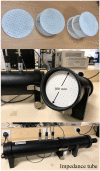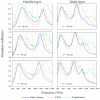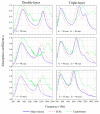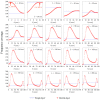3D Printing of Polymeric Multi-Layer Micro-Perforated Panels for Tunable Wideband Sound Absorption
- PMID: 32041304
- PMCID: PMC7077450
- DOI: 10.3390/polym12020360
3D Printing of Polymeric Multi-Layer Micro-Perforated Panels for Tunable Wideband Sound Absorption
Abstract
The increasing concern about noise pollution has accelerated the development of acoustic absorption and damping devices. However, conventional subtractive manufacturing can only fabricate absorption devices with simple geometric shapes that are unable to achieve high absorption coefficients in wide frequency ranges. In this paper, novel multi-layer micro-perforated panels (MPPs) with tunable wideband absorption are designed and fabricated by 3D printing or additive manufacturing. Selective laser sintering (SLS), which is an advanced powder-based 3D printing technique, is newly introduced for MPP manufacturing with polyamide 12 as the feedstock. The acoustic performances of the MPPs are investigated by theoretical, numerical, and experimental methods. The results reveal that the absorption frequency bandwidths of the structures are wider than those of conventional single-layer MPPs, while the absorption coefficients remain comparable or even higher. The frequency ranges can be tuned by varying the air gap distances and the inter-layer distances. Furthermore, an optimization method is introduced for structural designs of MPPs with the most effective sound absorption performances in the target frequency ranges. This study reveals the potential of 3D printing to fabricate acoustic devices with effective tunable sound absorption behaviors and provides an optimization method for future structural design of the wideband sound absorption devices.
Keywords: 3D printing; acoustic absorption; micro-perforated panel; multi-layer structure; selective laser sintering.
Conflict of interest statement
The authors declare that there is no financial conflict of interest.
Figures












Similar articles
-
Exploring the acoustic potential of 3D printed micro-perforated panels: A comparative analysis.Heliyon. 2024 Mar 26;10(7):e28612. doi: 10.1016/j.heliyon.2024.e28612. eCollection 2024 Apr 15. Heliyon. 2024. PMID: 38601601 Free PMC article.
-
Enhancing sound absorption and transmission through flexible multi-layer micro-perforated structures.J Acoust Soc Am. 2013 Nov;134(5):3663-73. doi: 10.1121/1.4821215. J Acoust Soc Am. 2013. PMID: 24180777
-
Dynamic sound absorption characteristics of a series piezoelectric acoustic absorber regulated by voltage.J Acoust Soc Am. 2022 Jun;151(6):3807. doi: 10.1121/10.0011639. J Acoust Soc Am. 2022. PMID: 35778212
-
A review on powder-based additive manufacturing for tissue engineering: selective laser sintering and inkjet 3D printing.Sci Technol Adv Mater. 2015 May 5;16(3):033502. doi: 10.1088/1468-6996/16/3/033502. eCollection 2015 Jun. Sci Technol Adv Mater. 2015. PMID: 27877783 Free PMC article. Review.
-
3D printing of glass by additive manufacturing techniques: a review.Front Optoelectron. 2021 Sep;14(3):263-277. doi: 10.1007/s12200-020-1009-z. Epub 2020 Jul 10. Front Optoelectron. 2021. PMID: 36637727 Free PMC article. Review.
Cited by
-
Investigating the Potential of Transparent Parallel-Arranged Micro-Perforated Panels (MPPs) as Sound Absorbers in Classrooms.Int J Environ Res Public Health. 2023 Jan 13;20(2):1445. doi: 10.3390/ijerph20021445. Int J Environ Res Public Health. 2023. PMID: 36674200 Free PMC article.
-
Optimization of Extrusion-Based 3D Printing Process Using Neural Networks for Sustainable Development.Materials (Basel). 2021 May 22;14(11):2737. doi: 10.3390/ma14112737. Materials (Basel). 2021. PMID: 34067326 Free PMC article.
-
Investigation of factors affecting the sound absorption behaviour of 3D printed hexagonal prism lattice polyamide structures.Sci Rep. 2024 Dec 28;14(1):30852. doi: 10.1038/s41598-024-81496-7. Sci Rep. 2024. PMID: 39730617 Free PMC article.
-
Propagation of Sounds through Small Panels Made of Polymer Materials by 3D Printing.Polymers (Basel). 2023 Dec 19;16(1):5. doi: 10.3390/polym16010005. Polymers (Basel). 2023. PMID: 38201670 Free PMC article.
-
Additively manufactured hybrid auxetic structures for enhanced low frequency acoustic performance through experiments and modelling.Sci Rep. 2025 Jul 2;15(1):23460. doi: 10.1038/s41598-025-06970-2. Sci Rep. 2025. PMID: 40603437 Free PMC article.
References
-
- Maa D.Y. Theory and design of microperforated panel sound-absorbing construction. Sci. Sin. 1975;18:55–71.
-
- Maa D.Y. Microperforated panel wide-band absorber. Noise Control Eng. J. 1987;29:77–84. doi: 10.3397/1.2827694. - DOI
-
- Maa D.Y. Potential of microperforated panel absorber. J. Acoust. Soc. Am. 1998;104:2861–2866. doi: 10.1121/1.423870. - DOI
-
- Wu M.Q. Micro-perforated panels for duct silencing. Noise Control Eng. J. 1997;45:69–77. doi: 10.3397/1.2828428. - DOI
-
- Kang J., Brocklesby M.W. Feasibility of applying microperforated absorbers in acoustic window system. Appl. Acoust. 2005;66:669–689. doi: 10.1016/j.apacoust.2004.06.011. - DOI
LinkOut - more resources
Full Text Sources
Other Literature Sources
Miscellaneous

